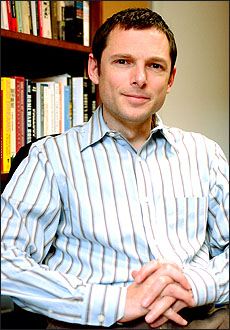Archives
Medicine as cultural symbol
Herzberg specializes in history of culture, gender and medicine
By JESSICA KELTZ
Reporter Contributor
David Herzberg says that joining the faculty at UB has allowed him to return to the things that drew him to academia in the first place.

David Herzberg says that now that he’s
a member of the UB faculty, he can spend more time finishing a book
manuscript on the cultural meanings of prescription drugs.
PHOTO: NANCY J. PARISI
"I know you're incredibly busy as a first-year faculty member, but when I accepted this job, I quit three other jobs," says Herzberg, an assistant professor in the Department of History, College of Arts and Sciences. "Now I get to do the parts of scholarship I like the most, which are reading, teaching and writing."
Herzberg says he's been working for several years on a book manuscript on the cultural meanings of prescription drugs, and is excited to spend more time finally getting it finished.
"Generally, after World War II, medicine and the prescription of medicine became more commercialized," he explains. "Different groups of people took advantage of prescription drugs' increased visibility as scientific wonders and as commercial goods to use them—not just as medicines, but as symbols or rallying points in larger social conflicts.
"They become famous, not just as a substance with physical effects; they become famous as a product," he points out.
An example Herzberg cites is Valium, the tranquilizer whose 1970s popularity he says second-wave feminists used to emphasize women's unhappiness and the way white middle-class women were stymied in the home.
But, he says, use of the drug dropped significantly after the "Valium scare" that ensued. Whether the phenomenon—which included widespread dissemination of the questionable statistic that one in three women were addicted to Valium—was "overblown" is hard to prove in retrospect, Herzberg says. He notes that the drug was the nation's most prescribed at one point, with more than 100 million prescriptions written per year, and that it's hard to disprove the assertion that millions of women had grown physically dependent on it.
While earning a Ph.D. at the University of Wisconsin-Madison, Herzberg wrote his dissertation on "Designer Consciousness: Medicine, Marketing and Identity in American Culture from Miltown to Prozac." He believes that certain drugs become popular, in part, because they ease, or are purported to ease, types of suffering that are very widespread.
"While it's not entirely clear just how good these drugs are, it is clear that a lot of people who are suffering do find relief from them," he says. In addition to the commonness of the symptoms, advertising, marketing, medicine, writers, activists and other actors all played roles in drawing popular fascination—and controversy—to the drugs, he explains.
More generally, Herzberg specializes in the history of culture, gender and medicine, as well as post-1945 American history. While he's considered to be a "cultural historian," he says that term could be considered more of an approach than a subject.
"I would say that most historians now practice at least some aspects of cultural history," he says. "It's no longer about studying a few rarified cultural forms. It's about looking at the production, circulation and significance of widespread, but contested, cultural meanings.
"This means more than just decoding things that are popular," he adds. "It's about understanding how and why particular groups of people invested these things with importance in the first place, and how and why others came to accept or resist their perspective."
Since joining the UB faculty in August, Herzberg has taught courses on post-1945 American history and "Modern American Popular Culture," as well as a graduate course in post-1945 readings and a graduate-level research seminar. He's looking forward to teaching a seminar next year on alcohol and other drugs in American history and to teaching the second half of U.S. history, which begins in 1877.
"Having 'T.A.'d' it so many times as a graduate student, I wanted to teach it my own way," he says.
Herzberg lives with his partner and their two children, ages 6 and 8, in the Elmwood area of Buffalo. He says he's lived in Buffalo three times before, one stint while doing extensive dissertation research in the Lockwood and Health Sciences libraries, and each time the city has seemed more dynamic and appealing.
"It's nice to be in the city," he says. "I like to be in a place where there's activity and many different kinds of people. I enjoy it a lot."
Moving to Buffalo from cycling-friendly Madison, he says he was concerned that he wouldn't get to do as much biking in Buffalo. But now, living near Delaware Park, he takes his kids biking all the time, he says. All in all, with the three past stints in Buffalo and the current job at UB, Herzberg says he feels like he's fated to be here.
"The perfect job for me opened up here right at the time I was looking for it," he says. "I couldn't be a happier guy."
